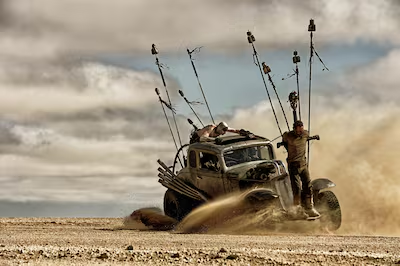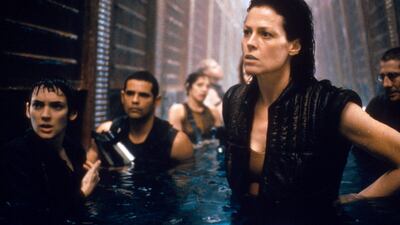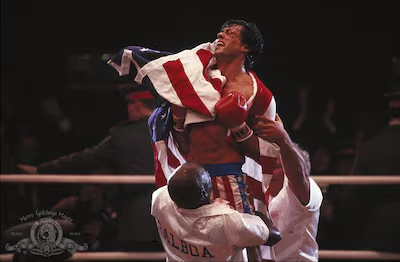Are we in the year of the fourquel? Judging from the film release schedule, it's hard to argue otherwise. This week, two highly anticipated follow-ups, Beverly Hills Cop: Axel F on Netflix and Despicable Me 4 in cinemas, will be released.
And that's with Bad Boys: Ride or Die and Kingdom of the Planet of the Apes and Kung Fu Panda 4 all still showing, the latter months after initial release.
While cynics might consider the fourquel to be a symptom of studios milking franchises to death, there have been a surprising number of excellent fourth entries into long-running series, with some the obvious high point of their respective franchises.
That's because producing a fourth film is often a sign of how healthy and full of potential a franchise is rather than it scraping the bottom of the barrel. Here are 10 of the best.
Mission: Impossible – Ghost Protocol
It's easy to forget now that the film has become so woven into the cultural fabric, but when the Brad Bird-directed fourth film in the Mission: Impossible series was released, the franchise was on shaky ground.
It had been five years since the moderately-successful third film, and Tom Cruise, the franchise's anchor, was coming off one of the weakest stretch of his career, with films Valkyrie and Knight and Day failing to make much of an impression.
It turns out, all he had to do to re-cement himself as his generation's greatest movie star and box office draw was to climb the world's tallest building unaided. Easy peasy.
And while the film's central set piece is its most memorable aspect, with the shot of Cruise on top of Dubai's Burj Khalifa having come to represent his ambitious career in the cultural imagination, the film itself is also a stellar blockbuster from start to finish, setting the tone and template for the rest of the series.
Mad Max: Fury Road

Mad Max: Fury Road is more than just the top entry in the post-apocalyptic franchise. It has also become, in the nine years since its release, widely considered one of the best action films ever made.
A work of unbridled ambition and brilliance by its visionary filmmaker George Miller, who also helmed the first three films in the series back in the 1970s and 80s, the anachronistic Fury Road features perhaps the best practical effects ever put to film, released at a time when the rest of Hollywood was phoning it in through green screen.
This is kinetic filmmaking at its best, full of memorable characters, bright colours and constant thrills. The film's prequel Furiosa may not have reached this film's heights, but that is because nothing can or probably will ever again. As a result, Fury Road will only get better with age.
Toy Story 4
Did we really need a Toy Story 4? That was the obvious question before it was released. After all, the third film was not only an excellent animation, it was also the perfect ending for the series.
In its tear-inducing climax, Andy, now grown up, says goodbye to the toys that he grew up with, including Buzz and Woody, handing them down to a new child to enjoy.
Toy Story 4 succeeded not by trying to undo that ending, but by asking what comes next for Woody, the cowboy doll voiced by Tom Hanks who had tied his entire identity to his former owner.
By following that route with emotional honesty, the film became a poignant achievement in its own right, becoming an existential and mature look at getting older, letting go, and how we define our own success as people. It's a template also working for Pixar's Inside Out 2.
Alien: Resurrection

The Alien franchise had experienced a bumpy ride with the third film, Alien3, which due to differences between director David Fincher and the production company received a muted reception.
For the fourth film, a different creative hand was needed, and the project was given to French director Jean-Pierre Jeunet. Having directed Delicatessen and The City of Lost Children, Jeunet had shown an artistic style that mixes the whimsical with the macabre.
Released in 1997, with Sigourney Weaver returning to play Ripley, the film was a box office success, making $160 million against its $75 million budget. Unfortunately, adoration for the film and its artistic merit would arrive years later upon re-examination, being more respected for the brave and outlandish choices it made.
Conquest of the Planet of the Apes
The first Planet of the Apes film was a hit upon release, prompting the production and release of four subsequent sequel films. The second and third film are great and have their fans, but with the fourth film, Conquest of the Planet of the Apes, the franchise was able to explore its philosophical and political theses against the real world.
The film shines through its performances but the set design of the dystopian city which took on a brutalist and industrial aesthetic really makes the fourth film a standout.
Lethal Weapon 4
Buddy cop films are a staple of action cinema and some of the best are in the Lethal Weapon series. If recent news is to be believed, officers Riggs and Murtaugh will be returning for a fifth film.
The last entry in the series came in 1998 with the fourth film which stars Mel Gibson and Danny Glover and also featured Chris Rock, Joe Pesci and martial arts star Jet Li.
The beauty of the fourth Lethal Weapon film lies in its attempt to join with the 1990s trend of bringing martial arts cinema to Hollywood. Director Richard Donner directs both the big bombastic scenes and the intimate fight scenes very well.
Star Trek IV: The Voyage Home
Star Trek began life as a television series in 1966 with stories of galactic conflict and cultural differences presented in a dense sci-fi adventure.
The show lasted for 80 episodes and kept growing in popularity even after it ended, giving way for its jump to the big screen with a feature film in 1979. Star Trek: The Motion Picture reunited the original cast and set the stage for multiple sequels.
The fourth film, Star Trek IV: The Voyage Home, does something not seen before in the series – put the crew of the USS Enterprise in 1980s San Francisco. The film is at its best when the space farers come face to face with normal everyday people, sequences that are full of laugh-out-loud humour and real heart.
Rocky IV

The Rocky film series really leaned into its purest form of training montages and fist pumping songs by the fourth film. Set against the backdrop of the cold war, the film’s villain is a Soviet boxer named Ivan Drago, portrayed most unforgettably by Dolph Lundgren.
The first Rocky entry is hopeful and heartbreaking, the second and third are thrilling boxing films, but there’s no easier and more fun watch than Rocky IV. The film ends with the cheesiest speech from Stallone’s Rocky urging the Soviet crowd to put aside their differences with the West and unite in their love for boxing. Somehow, it actually works.
Friday the 13th: The Final Chapter
Widely considered the best film in the Jason Voorhees slasher horror saga, the inaptly named Final Chapter (there's now 12 films in the franchise) may not be the kind of classic that transcends the genre like Halloween or The Exorcist, but it's a film that shows how downright fun a trashy 80s horror film can be.
It's a dish without new ingredients, merely high quality ones. Child star Corey Feldman (Gremlins, The Goonies, Stand By Me) joins the series opposite the always entertaining utility player Crispin Glover (Back to the Future's George McFly) for what starts as a teen comedy and quickly becomes a bloodbath when the masked monster of a man (he would become something a bit more supernatural after this one) returns to wreak havoc.
Bed and Board
Any fan of Richard Linklater's Before trilogy should find a way to watch the French director Francois Truffaut's five-film series The Adventures of Antoine Doinel. Filmed over a 20-year period, the story follows a Doinel, who is something of an on-screen alter-ego for its filmmaker, from childhood to adulthood.
When we first meet him in 1959 landmark The 400 Blows, one of the cornerstones of the French New Wave, he's a 14 year old struggling to fit in at work and school, disillusioned by an increasingly disappointing world.
His discovery that his mother is unfaithful in her marriage causes a crisis within him. When we meet him as an adult in Bed and Board, he's married the woman he pined for in the third film Stolen Kisses. But when a new infatuation sets up faces a potential infidelity of his own, he's become what he once despised.




